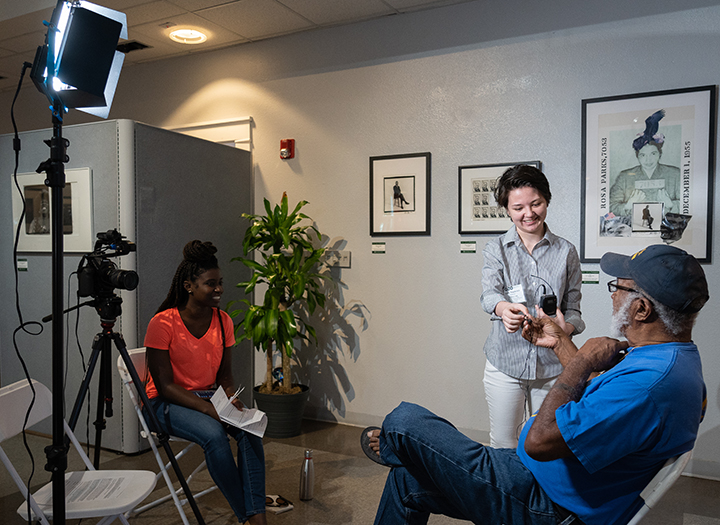About Us
Diversity & Inclusion

Black History presentation at Carter Woodson Museum
DIVERSITY, EQUITY & INCLUSION POLICY & PLAN OVERVIEW
The Department of Journalism and Digital Communication fosters diversity, equity and inclusion in our people, our teaching, our environment and our assessment of student learning.
We recognize global and domestic groups that have experienced de facto or de jure discrimination or under representation in mass media. We make special efforts to bring individuals and perspectives from these groups into our curricula, our classrooms and our conversations.
Dimensions of diversity can include, but are not limited to, sex, race, age, national origin, ethnicity, gender identity and expression, intellectual and physical ability, sexual orientation, income, faith and non-faith perspectives, socio-economic status, political ideology, education, primary language, family status, military experience, cognitive style, and communication style.
We actively demonstrate USF's core value of Diversity with Inclusion:
We affirm the value of diversity, individual dignity, equity, and our common humanity. Diversity of lived experiences, thought, and values enriches our lives and our whole university community. We seek the intentional inclusion of the broadest possible range of these perspectives essential to a university with local, state, national, and global impact.
DIMENSIONS OF DIVERSITY
We cultivate diversity, equity and inclusion in five ways:
1. Faculty & Staff Diversity
We believe that students best learn to seek and present diverse views throughout their lives when exposed to diverse voices in their university experience. We have hired faculty members with a variety of backgrounds and orientations, fully maintaining our commitment to diversity. Faculty résumés, activities, and teaching approaches and perspectives indicate success in hiring an intellectually and otherwise diverse faculty. When reviewing qualified candidates, we give preference to hiring faculty, staff and graduate assistants who represent global and domestic diversity.
Goal: Maintain or expand our current level of diverse faculty representation.
Action Steps:
- Recruit from a diverse population for future faculty openings.
- Advertise for open positions through a wide range of publications, targeting those likely to be noticed by diverse applicants.
- Maintain faculty diversity by providing opportunities for full participation in all teaching, research and service pursuits available at the University.
- Seek accomplished adjuncts who also represent diverse backgrounds.
2. Student Diversity
Our Department has a genuine culture of showing concern for minority students, nurturing them and helping them succeed. The diversity rate for students in our Department is higher than the University average, attesting to the culture of acceptance we strive to foster.
Goal: Maintain or grow a diverse student population.
Action Steps:
- Engage with local and regional K-12 programs to recruit students from diverse populations.
- Market programs internationally via social media, our websites, and other digital platforms.
- Create a respectful, inclusive environment.
- Recruit students from across campus with selected courses open to non-majors.
- Provide assistantships and other incentives to international students.
3. Diversity Across the Curriculum
We seek opportunities to incorporate diverse ideas, perspectives and people throughout our curricula. Elements of curricular diversity include assignments, modules, and, in some cases, entire courses, such as Neighborhood News Bureau, a core class, and Race, Class, and Gender, an elective. We require all undergraduate majors and encourage graduate majors to hone their journalistic skills in Midtown, an historically African American community in St. Petersburg. We include our commitment to diversity, equity and inclusion in all syllabi and, explicitly or implicitly, through stated objectives and assignments. We reward students’ efforts to be inclusive as a basis for evaluation.
Goal: Incorporate meaningful experiences with diversity in every required and elective class.
Action Steps:
- Continue reflecting on cultural representations in courses.
- Update courses to include current events from diverse perspectives.
- Highlight good and bad examples of minority representations across the media.
- Monitor how industry changes, especially with regard to digital technologies, impact diversity in newsrooms.
- Create opportunities for students to experience diversity in and around the campus community.
4. Atmosphere of Inclusion Inside & Outside the Classroom
We are committed to encouraging diverse voices and having hard discussions. Faculty and staff model and insist on respect and civility in all that we do.
Goal: Maintain a culture where all students, faculty and staff feel free to express opinions, talk about difficult topics, and disagree with care and consideration.
Action Steps:
- Organize campus conversations about free speech, civic engagement and divergent viewpoints.
- Invite accomplished guest speakers, lecturers and professionals who present students with novel ideas.
- Encourage students to ask difficult questions and engage in challenging conversations.
- Provide access to a wide range of publications and diverse media.
- Value respectful interactions above all.
5. Diversity as a Student Learning Competency
We have mapped ACEJMC’s diversity competency to multiple required courses in both programs, providing ample opportunity for mastery.
Goal: Ensure all students in all programs are exposed to the domestic and global diversity competency in multiple classes prior to graduation.
Action Steps:
- Include our commitment to diversity, equity and inclusion in all syllabi, explicitly or implicitly, through stated objectives and assignments.
- Seek and use materials about diversity, equity and inclusion by diverse authors as part of course materials.
- Reward students’ efforts to be inclusive as a basis for evaluation.
- Ensure diversity competencies continue to be well-represented across our programs.
We review our progress toward these goals annually. Last revised November 2022.